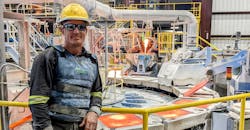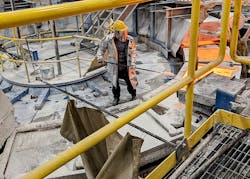A Cool Way to Manage Heat Stress
The average high temperatures in Shelby, NC, are generally pleasant, ranging from 47°F in January to nearly 90°F in July, but it’s a different story inside the Ames Copper Group plant there. The smelting and refining furnaces used to recycle copper scrap into 99.7% pure copper anodes also generate a lot of heat. In that environment, working is a challenge, especially for anyone wearing aluminized PPE, tending furnaces, and casting molten metal. But they’re keeping things cool.
Ames Copper Group melts copper scrap (wire, wire nodules, and both heavy and light copper) in tilting rotary furnaces so that impurities (including lead, tin, and iron, among other elements) can be deslagged from the molten metal. The refined metal is cast into copper anodes.
Turning copper scrap into copper anodes takes about 24 hours, and crews work in 12-hour shifts. Three operators work on the floor of the plant within a casting perimeter, along with a supervisor and a production manager. The three operators are responsible for keeping the molds free of debris; eliminating slag build-up in the ladles and launders; monitoring temperatures; and performing necessary maintenance.
“Our casting process usually lasts five-and-a-half to six hours, and during that time these guys are face-to-face with molten copper,” explained EHS manager Brian Scott. Recently he became responsible for the safety of the crew he oversees and recognized the need for something to help those workers mitigate temperatures up to 100°F on the production floor. Absent any protection, those workers are at risk of contracting heat illness or worse.
Previously, Scott made sure the crew stayed hydrated and took breaks when needed, but he found an extra layer of protection in a line of cooling vests developed and manufactured by StaCool Industries, which incorporate frozen thermal packets inserted into pockets to help regulate core body temperatures. vests are available to be worn under or over clothing, and each style is fully adjustable to ensure a proper fit for any body type.
“All of my guys here say it’s a game changer for what we do,” according to Scott.The ThermoPacks are inserted into pockets on either side of the vest, so their weight is evenly distributed around the wearer’s body, for effective cooling. The material used to form the ThermoPaks is entirely non-toxic, non-flammable, and FDA-approved, so it can be used in direct contact with food.
Each worker in the “heat zones” starts his shift wearing a StaCool vest. If a worker is off the casting floor, away from the furnaces and smelting process, one set of ice packs in a vest can last up to five hours.
If a worker is operating within the casting perimeter, especially if lancing or casting molten copper, he will wear the vest over a shirt, but under the aluminized jacket that protects each of them against the radiant heat and metal splashing. In addition to the jackets and shirts, workers wear fire-resistant pants, safety-toed shoes, hard hats, heat-resistant face shields, and several different types of gloves.
Someone wearing an aluminized suit or working close to the molten metal may need to replace the thermal packs more frequently. Switching out a ThermoPak is simple: the frozen packets are kept in a chest freezer in a separate, air-conditioned room off the floor, which also serves as a break room.
“We use it as a cooling station, as part of our heat mitigation program,” Scott explained. “They get some water, and they can change their ice packs out in there.”
At Ames Copper, each worker has his own vest. Because it is a relatively new operation, Scott spent some time researching what other metalcasting plants use to keep their workers cool. “Keeping core body temps down and staying hydrated are the staples of any good heat stress-management program,” Scott said.
When he discovered the StaCool vests, and after ordering one and trying it himself, Scott let other workers on the crew wear it to see how they felt after a shift. They reported they felt less depleted after working in the heat while wearing the vest, so “at that point, I got our site management here to agree to go ahead and make the purchase for all our operators,” Scott recalled.
“The StaCool team was great, and the vests were simple to work with and very user friendly,” he added.
Now, each of the workers has been issued a vest. “They’re not to share them with anyone else,” according to the EHS manager. The vests can be worn over or under clothing, depending on a wearer’s need. The vest supplier emphasizes that workers should be encouraged to determine and select the vest model that suits their own requirements.
And, importantly, Scott reported that since adopting the cooling vests the Ames Copper workers’ productivity has improved. StaCool keeps their core body temperatures low, and that makes a difference in how the workers feel at the end of their shift.
“It allows these guys to just stay energized,” said Scott. “There’s a difference when these guys are wearing the vests versus when they haven’t had them on.”

